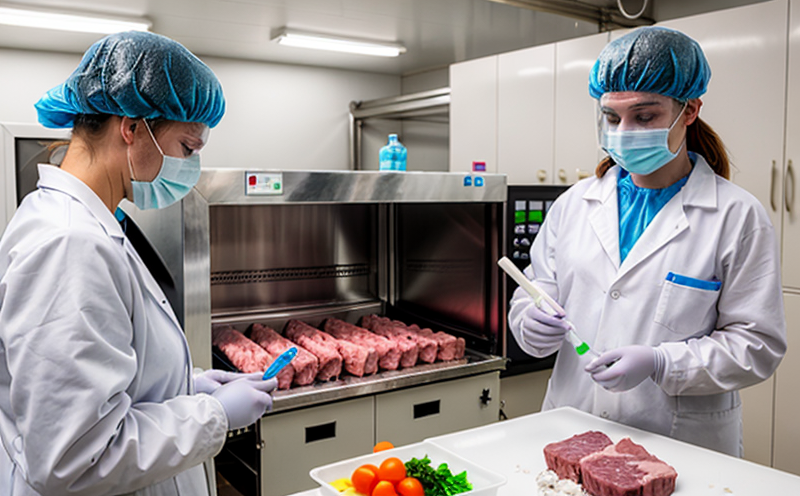Bioburden Enumeration Test
The Bioburden Enumeration Test is a critical procedure employed to quantify viable microorganisms present in dairy and meat products. This test plays an essential role in the quality assurance and safety of food items, particularly those that are susceptible to microbial contamination. The bioburden enumeration helps identify potential sources of pathogens and ensures product compliance with regulatory standards.
The process involves several steps, which begin with the collection of samples from various points within the production environment or directly from the products themselves. Samples are typically taken in sterile conditions using appropriate methods such as swabbing surfaces or collecting liquid volumes for homogenization. Once collected, these samples undergo a series of dilutions and inoculations into suitable media to encourage growth.
The chosen media supports microbial activity while inhibiting non-target organisms, ensuring accurate enumeration results. The samples are then incubated under controlled conditions that promote optimal growth rates of the targeted microorganisms. After incubation, colonies or individual units on the plates are counted manually or via automated colony counters, depending upon laboratory capabilities.
Following the enumeration process, the data is analyzed to determine the number of viable cells per gram or milliliter based on the initial dilution factors used during sample preparation. This information provides valuable insights into contamination levels throughout different stages of production processes and helps identify areas needing improvement.
The bioburden test is crucial for maintaining high standards in dairy and meat industries, ensuring that products meet stringent hygiene requirements set forth by global regulations like ISO 14025, ASTM E2937, EN ISO 6817. By identifying early signs of contamination, this testing method aids manufacturers in implementing preventive measures to maintain product quality and safety.
Furthermore, understanding bioburden levels allows for better risk assessment regarding potential hazards associated with specific types of bacteria or fungi present in raw materials used during processing stages. This knowledge enables companies to adjust their sanitation protocols accordingly, thereby reducing the likelihood of cross-contamination incidents occurring within facilities.
In summary, performing a thorough bioburden enumeration test ensures that dairy and meat products comply with international standards for hygiene and safety. It serves as an effective tool in monitoring product quality throughout various stages of production cycles, ultimately contributing towards maintaining public health by minimizing risks posed by harmful microorganisms.
Why It Matters
The significance of bioburden enumeration cannot be overstated when it comes to ensuring the safety and quality of dairy products. Microbial contamination can lead to spoilage, off-flavors, or even health risks if not properly managed during production processes. By regularly conducting bioburden tests, companies demonstrate their commitment to maintaining strict hygiene standards across all aspects of manufacturing.
For meat producers, accurate bioburden readings help track the effectiveness of cleaning procedures and identify any lapses in sanitation practices that could compromise product integrity. Regular monitoring also allows for early detection of contamination issues so corrective actions can be taken promptly before they escalate into larger problems.
From a regulatory perspective, compliance with established guidelines such as ISO 14025 ensures transparency and accountability within the industry. Adhering to these standards not only protects consumers but also builds trust among stakeholders who rely on consistent product quality from reputable suppliers.
In addition, understanding bioburden levels helps companies implement targeted interventions aimed at reducing contamination risks across supply chains. This proactive approach enhances overall food safety by fostering a culture of continuous improvement within organizations dedicated to producing safe and wholesome dairy and meat products.
Benefits
The implementation of bioburden enumeration offers numerous advantages for both manufacturers and consumers alike. For producers, this testing method provides crucial insights into the cleanliness levels achieved during different stages of production processes. By identifying areas where improvements are needed, companies can enhance their operational efficiency while simultaneously lowering costs associated with rework or scrap.
For end-users, knowing that the products they consume have been rigorously tested for microbial contamination offers peace of mind regarding food safety. Consumers expect transparency from trusted brands who prioritize quality assurance efforts like bioburden testing to protect public health and well-being.
In terms of sustainability, regular monitoring through bioburden enumeration contributes positively towards reducing waste by minimizing the occurrence of product spoilage due to microbial activity. Additionally, this practice supports responsible resource management practices by encouraging efficient use of raw materials throughout supply chains.
Moreover, compliance with international standards such as ISO 14025 not only enhances an organization’s reputation but also facilitates smoother interactions with trading partners abroad. International markets often require stringent quality controls before accepting imported goods, making adherence to global norms essential for successful export ventures.
Environmental and Sustainability Contributions
The bioburden enumeration test supports environmental sustainability efforts in several ways. Firstly, by identifying and addressing sources of contamination early on, companies can reduce the need for excessive chemical treatments or harsh sanitizers that might otherwise contribute to pollution if improperly managed.
Secondly, accurate enumeration helps optimize resource utilization throughout supply chains by ensuring only necessary quantities of raw materials are procured and processed. This minimizes waste generation while promoting responsible sourcing practices aligned with environmental protection goals.
Thirdly, the insights gained from bioburden tests enable manufacturers to develop more efficient production processes that consume fewer resources without compromising on product quality or safety standards. Such innovations contribute positively towards reducing carbon footprints associated with food manufacturing industries.
Lastly, adherence to international standards like ISO 14025 demonstrates a commitment to corporate social responsibility (CSR) initiatives aimed at fostering sustainable development within local communities and beyond. By embracing these practices, companies not only enhance their reputations but also contribute towards creating healthier living environments for all stakeholders involved.





